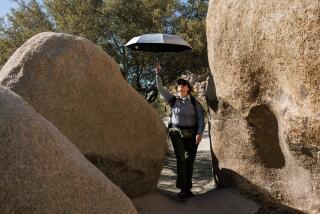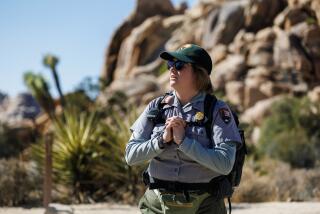Deadly Dangers Lurk Behind Utah’s Great Natural Beauty
- Share via
SALT LAKE CITY — The year 2003 was a deadly one in the Utah wilderness, capped by the Dec. 26 deaths of a group of snowboarders who chanced Provo Canyon and lost when an avalanche swept them away.
The deaths underscore the dark side of Utah’s backcountry, a dangerous outdoor playground that rewards prepared adventurers with unspeakable beauty but punishes the unprepared with disorientation, injury and even death. The state’s craggy peaks, slot canyons and trails can turn on anyone without notice.
State tourism officials, appreciative of the exposure given to Utah by the 2002 Winter Games, know that advertising comes with a price. “It has been a challenge to get word out to our out of state visitors” about Utah’s dangers, said Tracie Cayford, spokeswoman for the Utah Travel Council.
Before December’s avalanche, the year brimmed with tragedy in the backcountry:
* In March, a couple became trapped in their rented Jeep by a snowstorm while visiting Grand Staircase-Escalante National Monument. The woman died after the man began a long hike for help. The couple weren’t dressed for winter and had used their vehicle to navigate a road that even locals consider barely passable in the best weather.
* Two experienced skiers from San Diego got lost in a canyon near Powder Mountain in northern Utah last month. The pair were forced to spend the night in the canyon before they were found and brought out by a helicopter.
* A man was killed in May at the closed Alta ski area after skiing off a cliff.
* Three people were killed by lightning strikes in a month’s time last summer in the Uinta mountains of northeastern Utah. Strikes are random, but the incidents prompted authorities to remind hikers that the range is a magnet for bolts because it has more surface area, and thus more hot air rising to feed developing storms.
* A man was killed in May after a boulder fell and crushed him in Big Cottonwood Canyon. The man pushed his friend out of the way before he was hit.
* In an April incident that drew national attention, an experienced outdoorsman severed his own arm with a pocketknife to survive being trapped by a boulder.
* Two hikers who went missing in September in the Uinta mountains have not been found and are presumed dead.
Those episodes, and the hundreds more each year that have happier results, mean Utah rescue crews are an experienced bunch.
In the year that ended Wednesday, the state said county search and rescue teams were activated at least 520 times to help residents and visitors caught, lost or trapped. That’s up slightly from 2002, when at least 485 missions were launched.
Rescue teams, consisting mostly of trained volunteers, spent more than 40,000 hours combing woods, desert, and snow for wayward adventurers, the majority of them hikers who couldn’t find their way back in the frigid mountains of Utah and Salt Lake counties. Others became disoriented in southern Utah, which draws hikers and bikers with its towering red rock.
Last week’s search for the three snowboarders caught in the avalanche above Sundance Ski Resort was the 90th rescue mission of the year for Utah County’s rescue team. That’s up from 2002 and well ahead all other Utah counties. In the avalanche effort alone, searchers logged more than 2,000 hours.
The avalanche showed the might Mother Nature wields in winter. But she can be brutal in spring and summer too, dropping lightning and heavy rains that kill hikers in the Uintas and strand others in the southern Utah slot canyons.
“It’s very breathtaking, scenic, and at the same time it can be one of the most treacherous places when you’re not prepared,” said Utah County sheriff’s deputy Dennis Harris. “We never really know when Mother Nature might show up.”
Grand County, which includes the Moab desert, was second in Utah with 85 rescue missions. The area -- which also includes Arches National Park and Green River -- lures hoards of base jumpers, bikers, hikers, rock climbers and rafters.
The problem, officials say, is no more complex than adventurers underestimating nature and the dangers of the terrain.
In Grand County, hikers frequently are ill-prepared for rapidly changing elements and get lost, Sheriff James Nyland said. Instead of backtracking, they get caught on a ledge where they can’t get back up or down.
At least two base jumpers were killed in Grand County in 2003.
“You get people who think they can beat the odds. When you get out in the backcountry you’re always taking a risk,” Nyland said.
Tourism is a huge moneymaker for Utah, but all the rescue missions are costing taxpayers.
As of Dec. 30, the state had spent $153,223 on search and rescues. Counties, which usually lead the efforts, are reimbursed for their costs by a state-funded Search and Rescue Financial Assistance Program.
The fund, started in 1998, pays counties back for equipment, training and incidental costs and gets its money from a fee on off-road vehicle purchases, registered or renewed boats, and annual wildlife habitat authorizations.
Counties also set money aside for search and rescue. Grand County’s rescue budget was $100,000. Utah County’s budget wasn’t immediately available, though Harris said the county had exhausted the fund well before the year’s end.
Although the program helps the state keep a rough tally of the number of rescue missions each year, counties are only required to report those missions that qualify for reimbursement. That means the actual number of missions is probably larger that what is reported.
Should the rescued, or their relatives, get a bill? No, Harris says.
“I believe that if we charged for going out on search and rescue, I believe we’d have more people die because they’re worried about the cost,” Harris said.
Knowing the lay of the land, having proper clothing and food, a GPS unit, cellphone, avalanche beacon or even just a helmet could mean the difference between life and death, authorities say.
“Everybody tries to cut the corners, to save on expenses, and a lot of times the expense that’s cut out is safety equipment. It almost needs to be reverse,” Harris said.
More to Read
Sign up for The Wild
We’ll help you find the best places to hike, bike and run, as well as the perfect silent spots for meditation and yoga.
You may occasionally receive promotional content from the Los Angeles Times.






